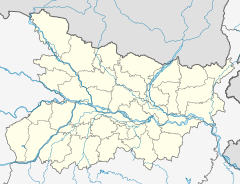
Deoghar is a major city in Jharkhand, India. It is a holy sacred place of Hinduism. The city is primarily known for Baidyanath Temple, one of the 12 Jyotirlingas of God Shiva. The sacred temples of the city make this a place for pilgrimage and tourists. The city is administrative headquarter of Deoghar District which comes under Santhal Parganas division of Jharkhand.

Deoghar district is one of the twenty-four districts of Jharkhand state in eastern India. Deoghar, the central city of the district, is also its administrative headquarters. This district is known for the Baidyanath Jyotirlinga shrine and is a part of the Santhal Pargana division. Deoghar is a Hindi word meaning abode (‘ghar’) of the Gods and Goddesses (‘dev’). Deoghar is also known as “Baidyanath Dham,” and “Baba Dham,”.
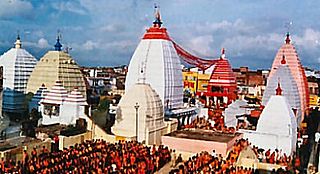
The Baidyanatha temple, also called Baba Baidyanath Dham is a Hindu temple dedicated to Shiva. It is located in Deoghar, in the Santhal Parganas division of the Indian state of Jharkhand.

The Kānvar Yātrā is an annual pilgrimage of devotees of Shiva, known as Kānvarias (कावड़िया) or "Bhole" (भोले), to Hindu pilgrimage places of Haridwar, Gaumukh and Gangotri in Uttarakhand and Ajgaibinath,Sultanganj in Bhagalpur, Bihar to fetch holy waters of Ganges River. Millions of pilgrims fetch sacred water from river Ganga and carry on their shoulders for hundreds of miles to offer it in their local Śiva shrines, or specific temples such as Pura Mahadeva temple in Baghpat district and Augharnath temple in Meerut, Kashi Vishwanath temple in Varanasi, Baidyanath temple in Deoghar etc. In 2023, the Kanwar Yatra was held from 04-15 July.

Chandika Sthan is a Hindu temple situated in Munger, in the India state of Bihar. It is one of the fifty-one Shakti Peethas, places of worship consecrated to the goddess Shakti. On the Northeast corner of Munger, Chandika Sthan is just two kilometers away from the Munger town. Being a Siddhi-Peetha, Chandika Sthan is considered to be one of the most sacred and sanctified temples, as important as the Kamakshya temple near Guwahati. Sati's left eye fell here and it is believed that those who worship here get rid of eye pain. It is one of the major Hindu pilgrimage centre in Ang Pradesh region of Bihar.

Belha Devi Temple is an old Hindu temple in the city of Bela Pratapgarh, dedicated to the goddess Belha, the local incarnation of the Devi.
Baba Garibnath Dham is a holy sacred place of Hinduism in Muzaffarpur in the Indian state of Bihar. Baba Garib Dham is one of the oldest temples of Lord Shiva and known as the Deoghar of Bihar. Devotees from all across the district and state come here to pray and wish for their better life ahead, It is believed that prayer during the month of Sawan has special significance, which helps to fulfill all wishes.

Moti Dungri is a Hindu temple complex dedicated to lord Ganesha in Jaipur, Rajasthan. It was built in 1761 under supervision of Seth Jai Ram Paliwal. The temple is a popular tourist attraction in the city and is located next to the Birla Temple
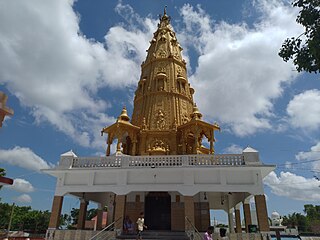
Sundarnath is a temple of Lord Shiva located in Kursakanta Araria of the Indian state of Bihar near the India–Nepal border, at Sundari Math. People from South Nepal and North Bihar worship the Hindu god Shiva. A Major historical temple dedicated to Lord Shiva in Ang Pradesh region of Bihar.

Hathiram Bhavaji or Hathiram Baba or Hathiram Bairagi was a saint from Raipur Dalpatpur Uparhar, Maya, Ayodhya who visited Tirumala around 1500 CE on a pilgrimage and became a devotee of Lord Venkateswara. He settled there by setting up an ashram near the temple. According to a legend, he had the privilege of playing dice with Venkateswara.

The Sikri Mata Temple, officially known as the Shri Mahamaya Devi Temple, is a Hindu temple at Sikri Khurd village, Ghaziabad district, Uttar Pradesh, India. The temple was built in the 17th century by Jalim Giri Baba and his family, who belonged to the Goswami community of the village. Its administration was taken over from the descendants of Giri Baba by the gram panchayat in 1977. Dedicated to the goddess Sikri, who is believed to be an incarnation of Durga, the temple attracts large gatherings of visitors during the biannual festival of Navaratri. During the Chaitra month of Navaratri, marking the beginning of a new year on the Hindu calendar, a large historical fair is organised for nine days. The fair was cancelled in 2020 due to the COVID-19 pandemic for the first time since 1918. There is a banyan tree on the temple premises from which more than 130 revolutionaries were hanged to death during the Indian Rebellion of 1857.
Gandiveshwar Sthan is a place mentioned in the Hindu mythological epic the Mahabharata and a religious tourist centre for Hindu pilgrims. In the Mahabharata, when the Pandavas were exiled from their kingdom to the forest by the Kauravas, Arjuna hid his Gandiva bow and all his weapons under a shami tree, which adherents believe is at this site.
Maa Khadgeshwari Kali Mandir is a Hindu temple dedicated to Goddess Kali. It is a part of Hindu pilgrimage and located in Araria, in Araria district of Bihar, India.

Ghushmeshwar is a Shiva temple, claimed by devotees to be the twelfth Jyotirlinga of Lord Shiva in the Hindu religion, which is located in the village of Shiwar, Rajasthan, India.
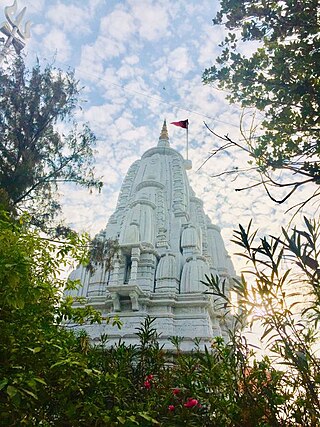
Shanaleshwara Swayambhu Temple dedicated to the worship of Lord Shiva. "Shanaleshwara" means, the sign that is worshiped as Lord Shiva. It is situated at 7 Kilometre away in the Nalas village of Rajpura, Punjab. It is maintained by the ascetic sadhu's of Juna Akhara Foundation.

Pancheshwar Nath Mahadev Mandir is a Hindu temple of Shiva in Madhwapur block of Madhubani district in Mithila region of Bihar. An annual four day Ganesh Puja festival is organised by Ganesh Puja Samiti at the temple. An annual Durga Puja festival has been held since 1954, and is organised by Durga Puja Samiti. In the month of Sawan, local residents do Jalabhishek on the Shivling of the temple every Monday.
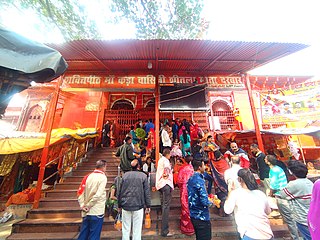
Sheetla Devi Temple is a Hindu temple dedicated to the mother goddess Shitala, located in Kara, a town located near Sirathu, on the banks of river Ganges in Kaushambi district of Uttar Pradesh. It is one of the 51 Shakti Peethas in Shaktism denomination of Hinduism. The deity of the temple is regarded as the Kuldevi of Purvanchal. It is also known as Kada Dham, Sheetlan and Sheetla Dham, Kada.
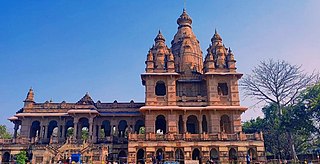
The Naulakha Temple is a Hindu temple located in Deoghar, Jharkhand, India. It is dedicated to the Hindu deities Radha and Krishna.

Shiv Shakti Temple, Bhagalpur is a Hindu Temple in Bhagalpur. It is devoted to Lord Shiva (Narmadeshwarnath) and Goddess Parvati. It is one of the Narmadeshwarnath temples. It is an important temple of Hinduism. It is especially crowded during Maha Shivaratri and Sawan Month .It gathers local people during Aarti every evening.
Sri Bhoothnath Mandir or Baba Bhoothnath Temple is a well-known temple located in Bhagalpur, a city in the Indian state of Bihar. The temple is dedicated to Lord Shiva, one of the principal deities in Hinduism. It is a place of worship and pilgrimage for devotees of Lord Shiva.

